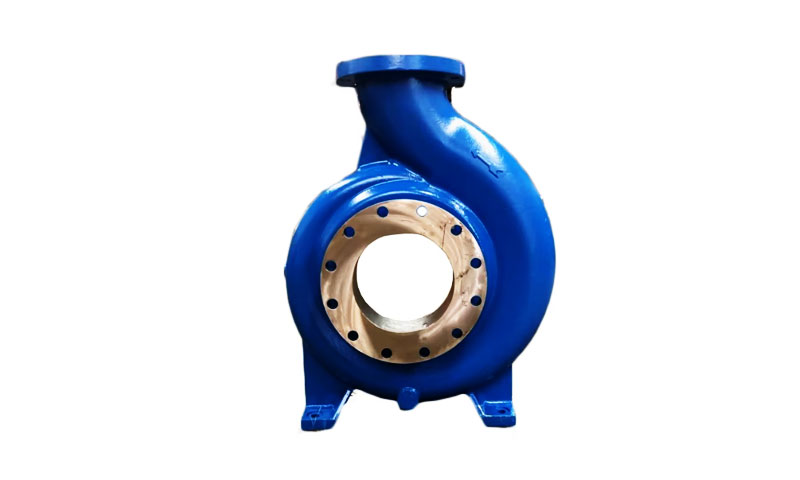1. Įvadas
Pump bodies are structural and hydraulic housings that convert driver energy into fluid motion. They commonly contain volutes, impeller seats, bearing bosses, flanges and internal passages.
The manufacturing route chosen for a pump body sets achievable geometry, metalurgija, cost and lead time.
Investment casting stands out where geometry is complex (internal guide vanes, thin webs, integrated bosses), tolerances are tight, and high-integrity alloys (nerūdijantis plienas, Nikelio lydiniai, Bronzos) yra reikalingi.
2. What Is an Investment Casting Pump Body?
Definition and core functionality
An Investicijų liejimas pump body is a pump housing produced by the lost-wax (investicija) liejimo metodas.
A wax (arba polimeras) pattern of the pump body is created, coated in refractory ceramic to build a shell, the wax removed by heating, and molten metal poured into the ceramic mold.
The fired shell is broken away after solidification to reveal a near-net cast pump body that is subsequently finished and inspected.
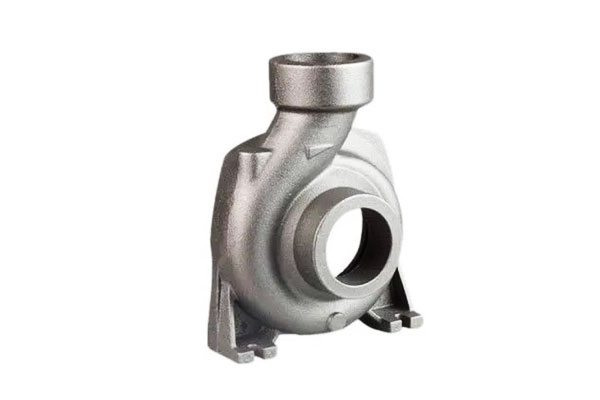
Typical specifications and dimensions
- Part mass: investment cast pump bodies usually range from a few hundred grams to tens of kilograms per piece; many foundries routinely cast pump bodies from ~0.5 kg up to ~50–100 kg depending on plant capability.
- Sienos storis: typical nominal walls for stainless or nickel alloys: 3–12 mm; minimum thin sections down to 1–2 mm are achievable in selected alloys and process control.
- Matmenų tolerancija (AS-CAST): general investment cast tolerances commonly fall in ± 0,1–0,5 mm for small features; percent-based tolerance of ±0.25–0.5% linear is a practical rule of thumb.
Critical machined features are usually left with machining allowance (0.2–2.0 mm depending on casting accuracy). - Paviršiaus apdaila (AS-CAST): typical Ra 1.6–3,2 μm (50–125 min) for standard ceramic shells; fine shells and careful pouring can produce Ra ≈ 0.8–1.6 μm.
Sealing faces or bearing journals are machined/lapped to much finer Ra (≤ 0.2 μm) as required.
3. Dizaino aspektai
Investment casting enables complex geometry, but good design practice maximizes quality and minimizes cost.
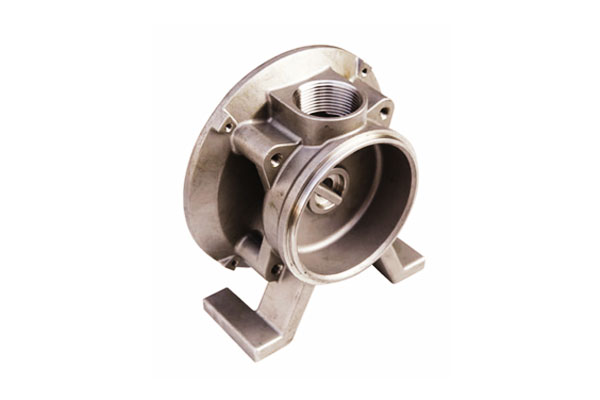
Hydraulic performance requirements
- Flow passages & volutes: smooth fillets and controlled convergence avoid separation and cavitation.
Internal fillet radii should be generous (≥ 1–2× wall thickness) to reduce turbulence. - Impeller seat alignment: concentricity and perpendicularity are critical — plan for machined bores and datum features.
- Clearances: pump clearances at impeller overhangs and seal faces must be maintainable by post-cast machining.
Structural requirements
- Stress & nuovargis: consider cyclical loads; use finite-element analysis to identify local stress risers.
Cast metallurgy (grūdų dydis, segregation) affects fatigue life—design to avoid thin, highly stressed bosses without proper filleting. - Vibration: stiff webs and ribs help raise natural frequencies; investment casting allows ribs to be integrated into the body.
Korozija & dėvėti
- Medžiagos pasirinkimas: choose alloy based on fluid chemistry (ph, Chloridai, erozinės dalelės, temperatūra).
For seawater, duplex or cupronickel may be required; for acids, Hastelloy or appropriate nickel alloys. - Erosion resistance: smooth internal surfaces and sacrificial coatings (kietas, Šiluminis purškiklis) are options where particulate slurry is present.
Matmenų nuokrypiai & paviršiaus apdaila
- Kritinės savybės: designate which faces/bores are finish-machined and specify machining allowances (Pvz., 0.5–1.5 mm for sandier shells, 0.2–0.6 mm for precision shells).
- Sealing surfaces: specify Ra and flatness; often lapped/polished to Ra ≤ 0.2 μm and flatness within 0.01–0,05 mm depending on pressure class.
4. Materials for Investment Casting Pump Bodies
Material selection is a critical factor in designing and producing investment-cast pump bodies, as it directly affects mechanical performance, atsparumas korozijai, Gamyba, ir tarnavimo gyvenimas.
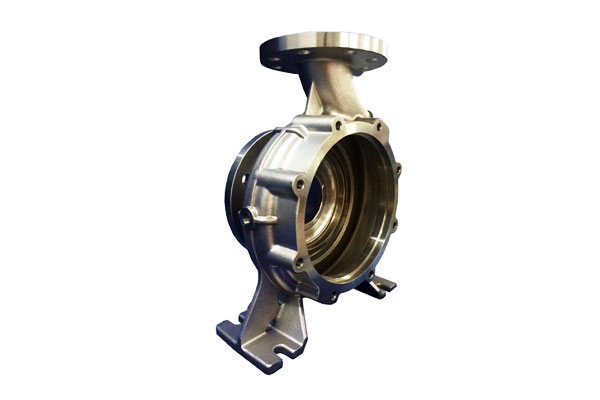
| Medžiagos kategorija | Lydinių pavyzdys | Pagrindinės savybės | Tipiškos programos | Laidos svarstymai |
| Austenitinis Nerūdijantis plienas | 304, 316L | Puikus atsparumas korozijai, Vidutinis stiprumas, Geras suvirinamumas; Tempimas: 480–620 MPa, Derlius: 170–300 MPa, Pailgėjimas: 40–60% | General chemical pumps, Vandens valymas, maistas & gėrimas | Good molten fluidity, low hot-cracking risk, easy post-machining |
| Dupleksinis nerūdijantis plienas | 2205, 2507 | Didelė jėga (Yield 450–550 MPa), superior chloride stress corrosion resistance | Marine and offshore pumps, Agresyvi cheminė aplinka | Requires controlled temperature; post-casting heat treatment to prevent sigma phase |
Nikelio lydiniai |
Inconel 625, 718; Hastelloy | Išskirtinis atsparumas korozijai, Aukštos temperatūros stiprumas, Atsparumas oksidacijai | Cheminis apdorojimas, energijos generavimas, aliejus & dujos | High melting points (≈1450–1600 °C); careful mold preheating and controlled pouring needed; difficult machining |
| Bronza and Copper Alloys | C93200, C95400 | Puikus atsparumas jūros vandens korozijai, Geras atsparumas dėvėjimams, antifouling; apatinis mechaninis stiprumas | Jūrų siurbliai, Jūros vandens aušinimas, Hidrauliniai komponentai | Lower melting points (≈1050–1150 °C) simplify casting; low thermal cracking risk; mechanical strength lower than stainless/nickel |
5. Investment Casting Process for Pump Bodies
Investicijų liejimas, Taip pat žinomas kaip Pamirštosios vaško liejimas, enables the production of pump bodies with complex geometries, Plonos sienos, ir aukšto matmens tikslumas.
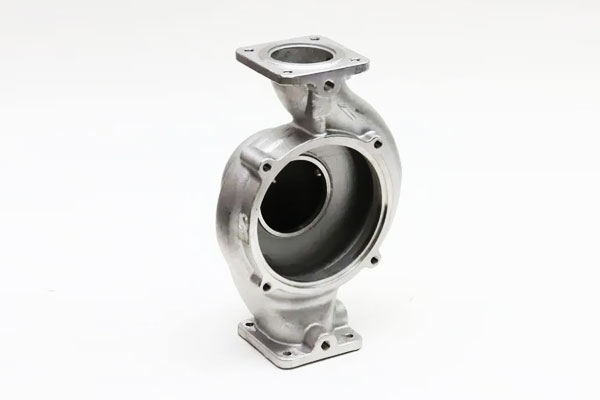
The process consists of several critical steps:
| Žingsnis | Aprašymas | Pagrindiniai svarstymai |
| 1. Vaško modelio kūrimas | Molten wax is injected into precision molds to form replicas of the pump body. | Ensure uniform wall thickness; maintain dimensional accuracy ±0.1 mm; use high-quality wax to prevent distortion. |
| 2. Assembly of Wax Tree | Individual wax patterns are attached to a central wax sprue to form a tree for batch casting. | Sprue design affects metal flow; minimize turbulence during pouring. |
| 3. Keraminio apvalkalo pastatas | Repeated dipping in ceramic slurry and stuccoing with fine refractory sand creates a strong, Šilčiai atsparūs apvalkalai. | Target shell thickness (5–10 mm) depends on pump body size; avoid cracks and porosity in the shell. |
| 4. Dewaxing and Mold Firing | Wax is melted out (autoclave or kiln), palikdamas ertmę; the ceramic shell is then fired to remove residues and strengthen the mold. | Temperature ramping must be controlled to prevent shell cracking; residual wax must be fully removed. |
5. Metalo liejimas |
Išlydytas metalas (Nerūdijantis plienas, nickel alloy, arba bronza) is poured into the preheated ceramic mold under gravity or vacuum-assisted conditions. | Pouring temperature and rate must ensure complete filling; control turbulence and prevent oxide formation. |
| 6. Kietėjimas ir aušinimas | Metal solidifies inside the mold; cooling rates affect microstructure, Mechaninės savybės, ir liekamasis stresas. | Thick sections may require controlled cooling to prevent porosity; thin walls must avoid hot tearing. |
| 7. Apvalkalo pašalinimas | Ceramic shell is broken away mechanically, often using vibration, sand blasting, or chemical dissolution. | Avoid damaging intricate pump channels or flanges. |
| 8. Finishing and Cleaning | Residual ceramic, gating system, and surface imperfections are removed via grinding, Šūvys sprogdinimas, or chemical cleaning. | Maintain dimensional tolerances; prepare surfaces for subsequent machining or coating. |
6. Operacijos po kaupimo
After the pump body is removed from the ceramic shell, several post-casting operations are performed to ensure the component meets functional, matmenys, ir paviršiaus kokybės reikalavimai.
These operations are critical for high-performance applications in chemical, jūrų, ir pramonės sektoriai.
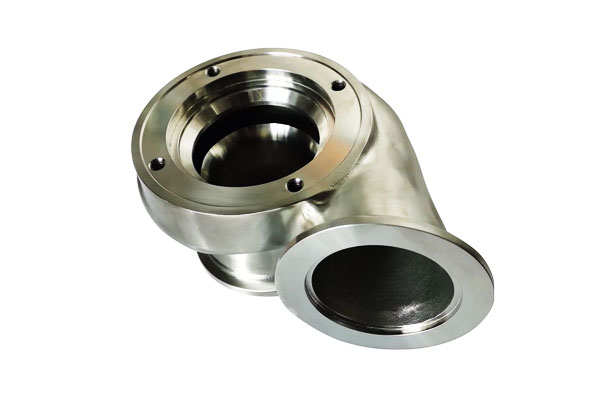
Terminis apdorojimas
Terminis apdorojimas is applied to relieve residual stresses, pagerinti lankstumą, and optimize mechanical properties:
- Streso palengvinimo atkaitinimas: Heating to 550–650 °C for stainless steels reduces residual stress from casting and prevents distortion during machining.
- Sprendimo atkaitinimas: Applied for stainless steels and nickel alloys to homogenize microstructure and dissolve unwanted precipitates, ensuring corrosion resistance and consistent hardness.
- Aging or Precipitation Hardening (for certain alloys): Enhances strength and wear resistance in high-performance materials.
Apdirbimas
Critical dimensions such as flanges, gręžiniai, mating surfaces, and threaded ports are machined to meet tight tolerances.
Typical machining operations include turning, frezavimas, gręžimas, and boring. Machining ensures:
- Dimensional tolerances of ±0.05–0.1 mm for precise assembly.
- Smooth sealing surfaces to prevent leaks in high-pressure applications.
Paviršiaus apdaila
Paviršiaus apdaila padidina atsparumą korozijai, atsparumas nusidėvėjimui, ir estetika:
- Poliravimas: Improves smoothness for sealing faces and internal channels.
- Šūvys sprogdinimas: Removes residual ceramic particles and creates a uniform surface for coating or painting.
- Dangos: Optional chemical or electroplated coatings (Pvz., Nikelis, Ptfe) enhance corrosion resistance and reduce friction.
Neardomieji bandymai (Ndt)
To detect defects such as porosity, įtrūkimai, or inclusions, NDT is performed:
- Radiografija (Rentgeno spindulys): Identifies internal voids and inclusions.
- Ultragarsinis bandymas (UT): Detects subsurface flaws in thick sections.
- Dažų skvarbių bandymų (Pt): Reveals surface cracks and porosity.
Cleaning and Inspection
Pagaliau, pump bodies are cleaned to remove residual machining oils, Šiukšlės, or salts. Dimensional and visual inspections verify compliance with specifications before assembly or shipment.
7. Quality Assurance and Testing
Kokybės užtikrinimas (QA) is critical in ensuring that investment casting pump bodies meet design specifications, performance standards, ir pramonės reikalavimai.
A systematic QA approach combines dimensional checks, Mechaninis bandymas, and non-destructive evaluation to detect defects and confirm functional integrity.
Matmenų tikrinimas
Dimensional verification ensures that the pump body conforms to design drawings and tolerances:
- Koordinačių matavimo mašinos (Cmm): Measure complex geometries, gręžiniai, flanšai, and mounting surfaces with accuracy of ±0.01–0.05 mm.
- Gauge Tools: Thread gauges, plug gauges, and height gauges verify critical features quickly in production.
- Paviršiaus šiurkštumo matavimas: Confirms finishing requirements for sealing faces and internal channels (Pvz., Ra ≤0.8 μm for hydraulic components).
Mechanical Property Verification
Mechanical testing validates that the material meets required strength, ausmingumas, ir kietumas:
- Tempimo bandymai: Measures yield strength, ultimate tensile strength, ir pailgėjimas, ensuring the material can withstand operational loads.
- Kietumo tikrinimas: Rockwell or Vickers testing confirms that heat treatment and material processing achieved the desired hardness.
- Poveikio bandymas (Jei reikia): Evaluates toughness for applications exposed to fluctuating loads or shock.
Neardomieji bandymai (Ndt)
NDT techniques detect hidden defects without damaging the part:
- Radiografija (X-ray/CT Scanning): Identifies internal porosity, intarpai, and voids, particularly in thick sections.
- Ultragarsinis bandymas (UT): Detects internal cracks, tuštumos, or delaminations in dense materials like stainless steel and nickel alloys.
- Dažų skvarbių bandymų (Pt): Reveals surface cracks, Pinolės, or fine porosity not visible to the naked eye.
- Magnetinių dalelių bandymas (MT): Applied for ferromagnetic alloys to detect surface and near-surface discontinuities.
Common Casting Defects and Mitigation Strategies
- Poringumas: Minimized through proper gating, ventiliacija, and controlled solidification rates.
- Susitraukiančios ertmės: Addressed via riser design and thermal management.
- Šaltas uždaromas ir klaidingas: Avoided by maintaining optimal pouring temperatures and smooth flow in complex geometries.
- Surface Inclusions: Controlled by using high-purity alloys and proper degassing techniques.
8. Advantages of Investment Casting for Pump Bodies
- Sudėtinga geometrija: Vidinės ištraukos, thin walls and integrated bosses with minimal secondary assembly.
- Beveik tinklo forma: reduces material removal vs. rough machining from bar or billet — often 30–70% less machining sudėtingoms dalims.
- Aukštas matmenų tikslumas & paviršiaus apdaila: less secondary finishing for many features compared with sand casting.
- Alloy flexibility: cast many stainless and nickel alloys with good metallurgical integrity.
- Small to medium production flexibility: tooling for wax patterns is relatively inexpensive vs. large die tooling, enabling economic runs from prototypes to thousands of parts.
9. Apribojimai ir iššūkiai
- Cost for very large parts: above certain sizes (dažnai >100 kg) investment casting becomes uneconomical compared with sand casting or fabricating/ welding.
- Švino laikas: pattern tooling, shell building and firing add lead time—prototype timelines usually measured in weeks.
- Porosity risk in thick sections: thick bosses or large cross-sections require careful gating, chills or segmenting to avoid shrinkage.
- Surface finish and tolerances depend on shell system: achieving ultra-fine finishes or extremely tight as-cast tolerances requires premium ceramic systems and process control.
10. Pramoninės programos
Investment casting pump bodies are used across a broad spectrum of industries due to their complex geometry capabilities, materialus universalumas, ir aukšto matmens tikslumas.
The process allows engineers to design optimized hydraulic passages, Plonos sienos, and integrated mounting features that improve pump efficiency and longevity.
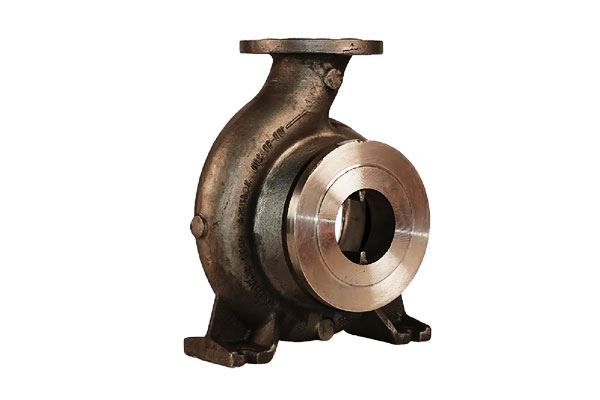
Chemical Processing Pumps
- Aplinka: Corrosive fluids such as acids, caustics, ir tirpikliai.
- Materials Used: Nerūdijantis plienas (316L, Duplex) and nickel alloys (Hastelloy, Inconel).
- Pagrindas: Investment casting enables intricate internal channels, minimizing turbulence and ensuring uniform flow, critical for chemical process reliability.
Water and Wastewater Pumps
- Aplinka: High-volume pumping, abrasive suspended solids, and variable pH levels.
- Materials Used: Bronza, Dupleksinis nerūdijantis plienas, and corrosion-resistant cast irons.
- Pagrindas: Thin-wall, smooth internal passages reduce clogging and energy losses, improving efficiency in municipal and industrial water systems.
Marine and Offshore Pumps
- Aplinka: Saltwater exposure, high-pressure operation, and cyclical mechanical stress.
- Materials Used: Vario lydiniai (Karinio jūrų laivyno žalvaris, bronza), Dupleksinis nerūdijantis plienas.
- Pagrindas: Resistance to corrosion and biofouling is critical; investment casting allows seamless, complex geometries to reduce maintenance and improve service life.
Aliejus & Gas and Power Generation Pumps
- Aplinka: Aukšta temperatūra, high-pressure fluids, and hydrocarbon-based media.
- Materials Used: High-nickel alloys (Inconel, Hastelloy), Nerūdijantis plienas, and cobalt-based alloys.
- Pagrindas: Investment casting supports high-strength materials and precise tolerances necessary for critical applications such as turbine lubrication, chemical injection, and offshore drilling.
Specialty and Custom Pumps
- Aplinka: Laboratory, Farmacija, or food processing applications requiring hygienic and precision performance.
- Materials Used: Nerūdijantis plienas (304, 316L), titanas, arba nikelio lydiniai.
- Pagrindas: Lygūs paviršiai, griežtos tolerancijos, and complex geometries achieved by investment casting ensure minimal contamination risk and compliance with regulatory standards.
11. Lyginamoji analizė
| Savybė / Kriterijai | Investicijų liejimas | Smėlio liejimas | Machining from Solid |
| Geometrinis sudėtingumas | Excellent – thin walls, Vidiniai kanalai, intricate features achievable | Moderate – limited by core placement and mold stability | Limited – complex internal geometries often impossible without assembly |
| Matmenų tikslumas | High – ±0.1–0.25 mm typical | Moderate – ±0.5–1.0 mm | Very High – ±0.05 mm achievable |
| Paviršiaus apdaila (Ra) | Fine – 1.6–3.2 μm typical; can be polished | Rough – 6–12 μm; requires machining for precision | Excellent – 0.8–1.6 μm achievable with finishing |
| Medžiagos parinktys | Wide – stainless steels, Nikelio lydiniai, bronza, vario lydiniai | Wide – iron, plienas, bronza, aliuminis | Wide – depends on machinable stock availability |
| Partijos dydis | Low-to-medium – 1–1000+ parts | Medium-to-high – economical for large, Paprastos dalys | Low – material waste increases cost for large parts |
| Švino laikas | Moderate – wax pattern & shell building required | Short-to-moderate – mold preparation relatively quick | Variable – depends on machining complexity |
Medžiagos atliekos |
Low – near-net shape reduces scrap | Moderate – gating and risers generate some waste | High – subtractive process creates chips and offcuts |
| Kaina už dalį | Moderate-to-high – tooling and process steps increase cost, economical for complex parts | Low-to-moderate – simpler molds, larger parts cheaper | High – extensive machining on large, complex parts is expensive |
| Stiprybė & Vientisumas | Excellent – dense microstructure, minimal porosity if controlled | Moderate – risk of sand-related inclusions and porosity | Excellent – homogeneous, Nėra liejimo defektų |
| Post-Processing Required | Often minimal – some machining, apdaila | Usually significant – machining and finishing required | Minimal – final finishing for tight tolerances only |
| Tipiškos programos | Pump bodies with thin walls, complex hydraulic channels, atsparumas korozijai | Didelis, simple pump housings or structural components | Custom or prototype pump bodies requiring extreme precision |
12. Išvada
Investment casting pump body combines design freedom with metallurgical integrity, making them an excellent choice for many fluid-handling applications—especially where complex internal geometry, exotic alloys or tight tolerances are required.
Success depends on early design for casting, informed material selection, careful process control (pilti, shelling, terminis apdorojimas), and robust QA/NDT programs.
For critical pump systems—marine, chemical or power generation—investment casting can deliver reliable, economical components when specified and executed correctly.
DUK
What maximum size of pump body can be investment cast?
Typical shop practice ranges up to ~50–100 kg per part, but the practical maximum depends on foundry capability and economics.
Very large pump bodies are more often produced by sand casting or fabricating/welding.
How much machining allowance should I design into an investment casting?
Leisti 0.2–2,0 mm depending on the criticality and shell precision. Specify tighter allowances only where the foundry guarantees precision shells.
Which material is best for seawater pump bodies?
Duplex stainless steels and selected copper-nickel alloys are common choices due to superior chloride pitting resistance and biofouling performance; final selection depends on temperature, velocity and erosion conditions.
What is the typical turnaround time for an investment-cast pump body?
Small production runs typically take 4–8 savaitės from pattern approval to finished parts; single prototypes can be faster with 3D-printed patterns but still require shell firing and melt schedules.
How do I specify acceptance criteria for porosity?
Use industry NDT standards (Radiografija, Ct, UT) and define acceptance levels in percent porosity by volume or via reference images.
Critical pressure-retaining pump bodies often require porosity <0.5% by volume and radiographic acceptance per customer standard.
